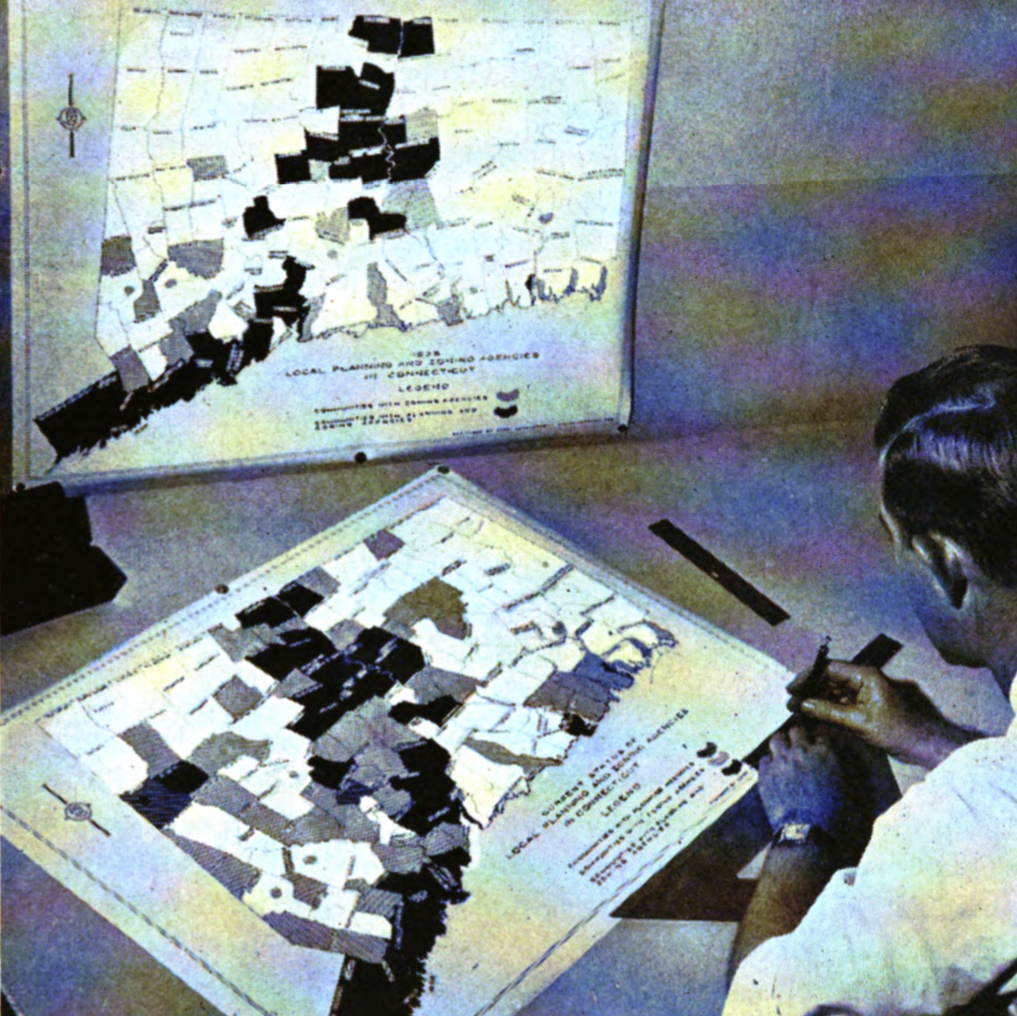Expanding Zoning Across Connecticut
After state legislators allowed local governments to enact their own zoning regulations in 1923, Connecticut’s growth over the next century has been defined by town leaders who successfully expanded restrictive land-use policies. Exclusionary zoning policies were widely embraced by nearly all of Connecticut’s 169 municipalities, particularly in rising suburban and rural areas outside of city centers. Beginning in 1939, the growth of zoning was loosely tracked by the Connecticut Development Commission, a state agency created to promote economic growth and efficient planning for industry and housing. The Commission published a series of maps to illustrate the rise of local planning and zoning agencies in Connecticut, as shown in Figure 3.13 from its 1944-1946 report. Towns that enacted local zoning policies tended to be clustered in the rapidly-growing suburbs around the state’s major cities of Hartford, Bridgeport, and New Haven. By 1957, 77 percent (131 out of 169) of town governments had established some type of planning and/or zoning agency, as shown in Figure 3.14. Nearly every town within a 20-mile radius of Hartford—including outlying rural areas far from the city center—enacted some type of land-use agency to exert control over what kind of housing could be built in their community.120

Figure 3.13: A Connecticut Development Commission employee reviews a 1938 map of local planning and zoning agencies in order to create an updated version in this photo from their 1944-1946 report. Zoning grew most quickly in suburban towns clustered around the major cities of Hartford, Bridgeport, and New Haven.
Figure 3.14: Explore the full-size interactive map. By 1957, more than 77 percent of town governments had established some type of planning and/or zoning agency, including nearly every town within a 20-mile radius of Hartford, according to the Connecticut Development Commission. View historical sources and map code, developed by Jack Dougherty and Ilya Ilyankou.
Why did zoning expand across Connecticut, and how did the level of exclusivity vary across different communities? One key factor was suburban competition for rising property values. Rising suburban leaders sought to attract upper-income families to purchase homes in their town, which would raise everyone’s property values and generate tax revenues, without increasing the percentage cost of public services, such as schools. Until the mid-1970s, Connecticut’s public schools were funded almost entirely by local property taxes, with limited contributions from state or federal funds. Suburban towns largely funded their schools independently because colonial-era Connecticut eventually carved the state into 169 separate local governments, rather than county governments that pooled together resources to fund an entire metropolitan region. As a result, the primary goal for most suburban leaders was to increase the combined value of all taxable property, also known as the grand list, meaning the town assessor’s official estimate of the value of all homes, businesses, farms, and factories within its borders. Although attracting more homebuyers would increase the population and overall school costs, suburban leaders calculated that the children of upper-income families would be less expensive to educate than those of lower-income families, and economies of scale meant that the percentage of tax revenue spent on schools and other public services would remain stable.
Exclusionary zoning made economic sense for suburban leaders because it effectively limited new home growth to wealthier homebuyers, raised property values for all, and sought to keep overall school costs relatively steady. This dynamic sparked a mid-twentieth-century “zoning race” between rising Connecticut suburbs that increased minimum-land requirements to attract wealthier single-family homeowners, and prohibited affordable multi-family housing to keep out lower-income families. When zoning policies and property values served the interest of suburban homeowners, they were incentivized to vote for local leaders who embraced this exclusive fiscal equation—which also kept out potential opponents—thereby reinforcing in insular cycle of suburban politics.
Comparing Zoning in Three Suburbs
Consider the example of how zoning evolved in three adjacent but very different suburban towns in the Hartford region: West Hartford, Bloomfield, and Avon. To some degree, their differences in the timing of zoning policy can be explained as a response to population growth. West Hartford became the first to enact zoning during its housing boom and high growth rate of the 1920s, when the population increased 182 percent, as shown in Figure 3.15. In neighboring Bloomfield, town leaders initially hired a zoning expert in the late 1920s, but did not actively expand its zoning policies until its peak growth decade of the 1950s, when its population climbed 137 percent. Meanwhile in Avon, most residents of this farming community initially opposed zoning in the 1930s, but changed course by hiring their own zoning expert in the 1950s, when the population rose 66 percent, and approved even more exclusive minimum-land requirements than their neighboring towns.121
Figure 3.15: Explore the full-size interactive chart, which uses a logarithmic scale to better compare growth rates for small and large communities. To some degree, the timing of major zoning policies was driven by sharp population growth in each suburb: West Hartford in the 1920s, Bloomfield and Avon in the 1950s. Source: US Census. View historical data.
When look more closely at how towns zoned land during this period, Hartford-area suburbs competed against each other, though not always successfully, with higher minimum-land requirements designed to attract higher-income homebuyers. Back in 1924, West Hartford’s most exclusive zone required 9,000 square feet of land for a single-family home. By the mid-1950s, they raised the top zoning level to 18,000 square feet of land for a single residence (today called R-18), as shown in Figure 3.16. By comparison, Bloomfield’s most exclusive zone at that time required 40,000 square feet of land for a single residence (R-40). Even more extreme, Avon’s most exclusive zone in the mid-1950s required 87,000 square feet (about 2 acres) of land for a single residence (R-87).122
Figure 3.16: Explore the interactive map by floating your cursor to view mid-1950s minimum-land zoning requirements in three suburban towns: Avon, Bloomfield, and West Hartford, Connecticut. To draw meaningful comparisons, we digitized and stitched together mid-1950s paper zoning maps from the three town governments, and converted their minimum-land-per-residence rules into a common scale with modern labels, such as R-87, which means 87,000 square feet of land (about 2 acres) is required to build a single-family home. View historical sources and map code, developed by Jack Dougherty and Ilya Ilyankou.
During the mid-1950s the minimum amount of land required per single residence in Avon’s most exclusive zone (R-87, or 87,000 square feet) was more than two times larger than Bloomfield’s most exclusive zone (R-40, or 40,000 square feet), and more than four times larger than West Hartford’s most exclusive zone (R-18, or 18,000 square feet), as shown in Table 3.4.
| Town | Zone | Min. land per residence | Scale diagram |
|---|---|---|---|
| Avon | R-87 or East | 87,000 sq ft |  |
| Bloomfield | R-40 | 40,000 sq ft |  |
| West Hartford | R-18 or AAA | 18,000 sq ft |  |
Icons by Georgiana Ionescu.
Furthermore, looking at how much land each suburban town designated as its most exclusionary residential zones in the mid-1950s magnifies the issue, based on our comparisons as shown in Table 3.5. Avon designated 26 percent of its land at the most exclusive R-87 level, and 72 percent of its land at the R-30 level. Meanwhile, Bloomfield designated 32 percent of its land at its highest R-40 level, while West Hartford designated 31 percent of its land at its highest R-18 level.123
| Zone equivalent | Avon | Bloomfield | West Hartford |
|---|---|---|---|
| R-87 | 26% | ||
| R-40 | 32% | ||
| R-30 | 72% | 27% | |
| R-20 | 14% | ||
| R-18 | 31% | ||
| R-15 | 10% | ||
| R-10.5 | 19% | ||
| R-10 | 5% | ||
| R-9 | 24% | ||
| R-6 | 11% | ||
| R-3 | 6% | ||
| R-1 | 2% | ||
| non-residential | 2% | 12% | 7% |
| Total acres | 14979 | 16943 | 14333 |
Chapter conclusion… to come
Connecticut Development Commission, Report (Hartford, 1946), https://hdl.handle.net/2027/mdp.39015079960137, p. 19; Connecticut Development Commission, “Legislation Passed at 1957 Session of the General Assembly of Planning and Zoning Interest” (State of Connecticut, 1957), http://www.worldcat.org/oclc/1140223706; Connecticut Development Commission, “Department of Economic and Community Development Records” (Connecticut State Library Archives, 2019), https://cslarchives.ctstatelibrary.org/repositories/2/resources/635. See historical sources for 1957 map at https://github.com/ontheline/otl-planning-zoning-ct↩︎
See 1900-1960 population data at https://github.com/ontheline/otl-datawrapper. See similar use of logarithmic scale for comparative population growth across metropolitan Hartford towns of different sizes in Technical Planning Associates and Connecticut Development Commission, Wethersfield, Connecticut Plan of Development for Southwest Section: Report to the Town Plan Commission, Wethersfield, Connecticut Plan of Development for Southwest Section (New Haven, Connecticut: Technical Planning Associates, 1950), https://catalog.hathitrust.org/Record/102602086, PDF p. 18.↩︎
TODO FIX CITES: Avon Zoning Regulations (amended Oct 19, 1951, and Fall 1953); Bloomfield (adopted March 15, 1950); West Hartford (amended to Dec 3, 1951); adapted from Avon, “Present Zoning Fact Sheet [Map of Avon and Adjacent Towns]” (Joseph Moschner; Avon Town Planning Committee, Connecticut, January 1954), https://www.avonct.gov/planning-community-development/files/1956-pocd-maps-908; see also Bloomfield 1958 and West Hartford 1958 zoning map legends. Assume 1958 Bloomfield R-40 minimum lot width of 150 ft based on present-day requirements.↩︎
TODO: Note that a strict calculation might manually remove park areas from residential zone calculations (such as Pennfield State Park in Bloomfield), but towns did include them in zoning maps, so we left calculations as-is.↩︎
On The Line is copyrighted by Jack Dougherty and contributors and freely distributed under a Creative Commons Attribution-NonCommercial-ShareAlike 4.0 International license.